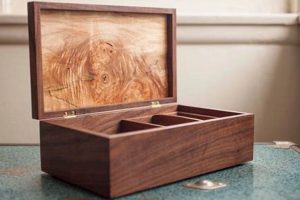A handcrafted, reusable countdown to Christmas, constructed primarily from timber. These festive structures frequently feature small compartments, designed to hold miniature gifts or treats for each day of the Advent season. Individuals often construct and personalize these calendars themselves, rather than purchasing pre-made versions.
The appeal stems from the opportunity for customization and the creation of a unique, heirloom-quality item. Constructing one of these calendars promotes creativity, provides a tangible representation of anticipation during the holiday season, and reduces reliance on mass-produced goods. Historically, Advent calendars have served as a visual and interactive means of marking the passage of time leading up to Christmas, enhancing the festive spirit within households.
The subsequent sections will address essential considerations for building a personalized version, including design choices, material selection, construction techniques, and decoration options. Furthermore, this article will explore safety precautions and offer practical tips for a successful crafting experience.
Construction Pointers
The following guidance aims to optimize the building process, ensuring a durable and visually appealing final product.
Tip 1: Material Selection: Opt for kiln-dried hardwood varieties, such as maple or birch, for structural integrity and longevity. Softwoods, like pine, are more susceptible to damage and warping over time.
Tip 2: Design Blueprint: Prioritize creating a detailed blueprint prior to commencing construction. Accurately measure and dimension all components, including the overall size, compartment dimensions, and spacing requirements. This step minimizes errors and material waste.
Tip 3: Precision Cutting: Employ power tools, such as a table saw or miter saw, to achieve accurate and clean cuts. Exercise caution and utilize appropriate safety equipment, including eye protection and hearing protection.
Tip 4: Secure Joinery: Utilize appropriate joinery techniques, such as mortise and tenon, dovetail, or biscuit joints, to ensure structural stability. Apply wood glue liberally to all joining surfaces and clamp securely until the adhesive cures completely.
Tip 5: Compartment Construction: Employ consistent compartment dimensions for uniformity and aesthetic appeal. Construct individual compartments using thin plywood or solid wood panels, ensuring a snug fit within the calendar’s frame.
Tip 6: Finishing Techniques: Apply multiple coats of a durable finish, such as polyurethane or lacquer, to protect the wood from moisture and wear. Sand lightly between coats to achieve a smooth, professional appearance.
Tip 7: Decoration Considerations: Exercise restraint when applying decorative elements. Opt for subtle embellishments, such as paint, stain, or wood burning, to complement the wood’s natural grain and avoid overwhelming the design.
Adherence to these recommendations fosters the creation of a lasting and cherished holiday tradition. The subsequent section will provide concluding remarks on the overall project.
1. Design Complexity
The level of intricacy chosen for a handcrafted timber countdown directly influences numerous facets of the project, impacting both its feasibility and ultimate aesthetic.
- Construction Time and Skill Requirements
Increasing design complexity directly correlates with increased construction time and necessitates a higher level of woodworking skill. A simple rectangular box with uniformly sized compartments requires minimal tools and expertise, whereas a multi-faceted structure with varied compartment shapes demands advanced cutting, joinery, and finishing techniques. Complex designs may incorporate intricate patterns, detailed carvings, or moving parts, extending the timeline from a few hours to several days or weeks.
- Material Waste and Cost
Complex designs invariably lead to increased material waste. Intricate cuts and non-standard shapes generate more scrap wood, increasing the overall cost of the project. For instance, a calendar with complex geometric shapes or irregular compartments will necessitate more precise cutting, resulting in more unusable material. Furthermore, complex designs may require specialized hardware or decorative elements, adding to the expense.
- Structural Integrity and Durability
While aesthetically appealing, highly complex designs can compromise structural integrity. Numerous small or intricate components are inherently weaker and more susceptible to damage than simpler, more robust designs. The increased number of joints and connections in a complex design also creates more points of potential failure. Proper joinery techniques and material selection become critical to mitigate these risks and ensure long-term durability.
- Aesthetic Impact and Personalization
Design complexity provides a greater canvas for artistic expression and personalization. Elaborate designs allow for the incorporation of intricate details, custom carvings, and unique decorative elements, reflecting the creator’s individual style and preferences. This increased potential for customization enhances the calendar’s sentimental value and makes it a cherished heirloom. However, a balance must be struck between complexity and visual coherence to avoid overwhelming the overall design.
Ultimately, the decision regarding design complexity requires careful consideration of the builder’s skill level, available resources, desired aesthetic, and long-term durability expectations. A simpler, well-executed design often surpasses a complex, poorly constructed one in terms of both functionality and visual appeal. The goal is to create a personalized festive countdown that remains a cherished part of holiday traditions for years to come.
2. Wood Selection
The selection of timber directly dictates the structural integrity, longevity, and aesthetic appeal of a handcrafted festive countdown. The choice of wood is not merely a superficial design consideration; it has a profound impact on the calendar’s resistance to warping, cracking, and general wear and tear. For instance, a construction employing softwood, such as pine, may exhibit dimensional instability and surface damage more readily than a calendar constructed from a hardwood, like maple or oak. Consequently, wood selection represents a foundational decision in the creation process.
Practical application of appropriate wood selection manifests in several ways. Employing kiln-dried lumber minimizes the risk of warping after construction, ensuring compartments retain their intended dimensions and doors or drawers function smoothly. The density of the chosen wood species influences the ease of joinery; hardwoods typically provide more secure and durable joints than softwoods. Furthermore, the wood’s grain pattern and natural color contribute significantly to the finished product’s visual character. The use of cherry wood, for example, lends a warm, reddish hue and a distinctive grain pattern, while walnut offers a darker, richer tone. Careful consideration of these factors enhances both the functional and aesthetic qualities of the calendar.
In summary, the understanding of the interplay between wood properties and construction requirements is crucial for crafting a durable and visually pleasing festive countdown. Selecting the appropriate wood is paramount in mitigating potential structural issues and maximizing the calendar’s lifespan. Challenges may arise in sourcing specific wood species or mastering advanced joinery techniques, but careful planning and execution ultimately yield a treasured holiday item. The thoughtful choice of timber elevates the resulting item from a mere object to a valued heirloom.
3. Compartment Size
The dimensions of individual receptacles within a handcrafted timber countdown directly dictate its functionality and influence the potential contents. Insufficiently sized compartments limit the range of treats or small gifts that can be accommodated, thereby diminishing the interactive appeal of the item. Conversely, excessively large compartments may appear disproportionate or aesthetically unbalanced, detracting from the overall visual presentation. The selection of appropriate compartment dimensions is therefore a critical design parameter. For example, compartments intended to house individually wrapped chocolates require different dimensions than those designed for small toy figurines. This interplay between compartment volume and anticipated contents necessitates careful planning during the design phase.
Practical application of dimensional planning manifests in several ways. Calendars intended for young children may feature larger compartments to accommodate age-appropriate toys or candies. Conversely, calendars designed for adults may incorporate smaller compartments to hold miniature cosmetics, jewelry, or gourmet treats. A well-executed design will balance the need for sufficient internal volume with aesthetic considerations, ensuring that the compartments complement the overall form factor of the calendar. Moreover, the internal dimensions must account for any dividers or internal structures within each compartment. Consideration of packaging dimensions also plays a key role; the compartments must comfortably accommodate the intended contents and any associated wrapping or protective materials.
In conclusion, the relationship between compartment size and overall functionality underscores the significance of thoughtful design planning. Inadequate or excessive compartment dimensions can negatively impact both the usability and visual appeal of a handcrafted countdown. Adhering to a well-defined dimensional plan is therefore essential for crafting a practical and aesthetically pleasing item. Although the challenge of selecting the appropriate compartment dimensions may necessitate iterative prototyping and careful consideration of anticipated contents, the resulting product is a cherished and functional symbol of the holiday season.
4. Joint stability
Joint stability is a critical determinant of a handcrafted festive countdown’s structural integrity and longevity. Inadequate joint construction can lead to component separation, warping, and ultimately, calendar failure. This consideration extends beyond mere aesthetic concerns; robust joinery directly impacts the functionality and long-term usability of the item. For example, weak joints in the compartment framework may cause doors to misalign, drawers to stick, or entire sections to detach under stress or repeated use. Therefore, prioritizing joint stability is fundamental to the successful fabrication of a durable calendar.
The practical implications of this principle are manifold. Employing appropriate joinery techniques, such as mortise and tenon, dovetail, or rabbet joints, significantly enhances the structural strength of the calendar. These methods, when executed precisely, create interlocking connections that resist stress and prevent separation. Proper adhesive selection further reinforces joint stability; high-quality wood glue, applied liberally and allowed to cure completely under clamping pressure, maximizes bond strength. Furthermore, the judicious use of mechanical fasteners, such as screws or dowels, can provide additional reinforcement, particularly in areas subject to high stress or repeated movement. Ignoring these considerations compromises the structural integrity and reduces the lifespan of the finished product.
In summary, joint stability is an indispensable element in the successful construction of a durable timber countdown. Neglecting this aspect can lead to premature failure and diminished functionality. By employing appropriate joinery techniques, selecting suitable adhesives, and utilizing mechanical fasteners where necessary, constructors can ensure that their calendar will withstand the rigors of repeated use and become a cherished heirloom. The inherent challenge lies in mastering these joinery methods and executing them with precision, but the resulting longevity and structural integrity of the calendar justify the effort.
5. Finish durability
The longevity and aesthetic preservation of a handcrafted timber countdown are intrinsically linked to the resilience of its applied finish. A durable finish functions as a protective barrier, shielding the wood from environmental stressors, physical abrasion, and the cumulative effects of repeated handling. Without adequate protection, the wood is susceptible to moisture absorption, leading to warping, cracking, or discoloration. Physical contact introduces scratches, dents, and the gradual erosion of surface details. Consider a calendar finished with a thin coat of wax; while initially appealing, the wax offers minimal resistance to moisture and abrasion, resulting in rapid degradation of the wood’s surface. The absence of a robust finish compromises the calendar’s structural integrity and diminishes its visual appeal.
The selection and application of an appropriate finish are therefore critical. Polyurethane, lacquer, and varnish represent viable options, each offering varying degrees of protection against moisture, scratches, and UV radiation. Multiple coats, applied meticulously and allowed to cure fully, provide enhanced protection compared to a single, thin layer. Sanding between coats creates a smooth, uniform surface, maximizing the finish’s protective properties and aesthetic appeal. For instance, a calendar coated with several layers of marine-grade varnish exhibits superior resistance to moisture and UV damage, making it suitable for environments with fluctuating humidity levels or prolonged exposure to sunlight. This level of protection ensures the calendar retains its original appearance and structural integrity for an extended period. Furthermore, employing a finish specifically formulated for wood projects enhances adhesion and prevents premature peeling or chipping, further extending the calendar’s lifespan.
In conclusion, finish durability is paramount in preserving the structural integrity and visual appeal of a handcrafted timber countdown. The judicious selection and application of a robust finish serve as a vital protective measure, shielding the wood from environmental stressors and physical damage. Although the application of multiple coats and the use of specialized finishes may increase the time and cost associated with the project, the resulting longevity and aesthetic preservation of the calendar justify the investment. The enduring quality of the finished product transforms it from a seasonal decoration into a cherished heirloom, capable of withstanding years of use and maintaining its original beauty.
6. Decoration Restraint
A fundamental principle in the creation of a handcrafted timber countdown involves the judicious application of ornamentation. Decoration restraint, in this context, signifies the conscious limitation of embellishments to enhance, rather than overwhelm, the underlying structure and material properties of the item. Excessive or incongruous decorative elements can detract from the inherent beauty of the wood, obscure the craftsmanship, and ultimately diminish the calendar’s overall aesthetic appeal.
- Material Integrity and Visibility
Decoration restraint allows the natural grain and texture of the wood to remain visible and appreciated. Overly elaborate decorations, such as thick layers of paint or excessive embellishments, conceal the wood’s inherent characteristics, negating the value of selecting a visually appealing timber species. A subtle stain or clear finish, complemented by minimal decorative accents, preserves the wood’s integrity and allows its beauty to shine through. This approach emphasizes the quality of the material and the skill of the woodworker.
- Aesthetic Harmony and Timelessness
Restrained decoration promotes aesthetic harmony and ensures the calendar remains visually appealing across changing trends. Simple, classic designs age gracefully, while heavily decorated items may appear dated or gaudy over time. Focusing on clean lines, balanced proportions, and minimal embellishments creates a timeless aesthetic that transcends fleeting fads and maintains its appeal for generations.
- Focus on Craftsmanship
Decoration restraint shifts the emphasis from ornamentation to craftsmanship. A sparsely decorated calendar draws attention to the quality of the joinery, the smoothness of the finish, and the precision of the construction. This approach highlights the skill and artistry of the creator, rather than relying on superficial embellishments to mask imperfections.
- Functional Clarity
Limited decoration enhances functional clarity by avoiding visual clutter. Excessive ornamentation can obscure compartment openings, confuse the numbering sequence, or impede the overall usability of the calendar. A clean, uncluttered design ensures that the calendar remains easy to use and understand, contributing to its practical value.
The application of decoration restraint elevates a handcrafted timber countdown from a mere seasonal decoration to a testament of enduring craftsmanship and understated elegance. By prioritizing material integrity, aesthetic harmony, functional clarity, and a focus on craftsmanship, creators can produce festive countdowns that are both visually appealing and structurally sound, ensuring their continued enjoyment for years to come.
7. Gifting options
The selection of gifts for inclusion within a handcrafted timber countdown necessitates careful consideration, directly impacting the calendar’s overall appeal and functional value. The gifting strategy transforms the structure from a mere decorative item into an interactive and personalized experience.
- Thematic Consistency
Maintaining a thematic focus across all 24 or 25 gifts enhances the calendar’s cohesiveness. Examples include a collection of miniature art supplies for a budding artist, a series of gourmet spices for a culinary enthusiast, or themed collectibles related to a particular hobby or interest. This approach elevates the calendar from a random assortment of items to a curated experience, reflecting the recipient’s personality and passions.
- Age-Appropriateness and Safety
The intended recipient’s age dictates the suitability of potential gifts. Small parts pose a choking hazard for young children, necessitating larger, safer alternatives. Similarly, gifts intended for adults may be inappropriate for children due to their complexity, fragility, or potential safety concerns. Prioritizing age-appropriateness and safety ensures the calendar remains a source of enjoyment and not a cause for concern.
- Variety and Progression
Varying the types and values of gifts maintains interest throughout the Advent season. A mix of consumable items, small toys or trinkets, and personalized notes creates a dynamic and engaging experience. Furthermore, increasing the value or significance of gifts as Christmas approaches can build anticipation and culminate in a memorable final reveal. The progression of gifts should align with the overall theme and recipient’s preferences.
- Practicality and Sentimentality
Balancing practical gifts with sentimental keepsakes enhances the calendar’s enduring value. Useful items, such as stationery supplies or small tools, provide immediate utility. Personalized notes, handwritten letters, or small photographs add a sentimental touch, transforming the calendar into a cherished memento. The combination of practicality and sentimentality ensures the calendar remains both functional and emotionally resonant.
In essence, the gifting strategy employed within a handcrafted timber countdown transforms it into a personalized and engaging experience. By considering thematic consistency, age-appropriateness, variety, and the balance between practicality and sentimentality, creators can elevate the calendar from a mere decoration to a cherished and enduring symbol of the holiday season.
Frequently Asked Questions
The following addresses prevalent inquiries regarding the design, construction, and long-term maintenance of these handcrafted festive items. Each response aims to provide clarity and facilitate a successful crafting process.
Question 1: What type of wood is most suitable for these projects?
Hardwoods such as maple, oak, or cherry are generally recommended due to their durability and resistance to warping. Softwoods, such as pine, may be used but require careful sealing and are more susceptible to damage.
Question 2: How are the compartments constructed to ensure durability?
Compartments should be constructed using robust joinery techniques, such as dovetail or mortise and tenon joints, in conjunction with high-quality wood glue. Reinforcement with screws or dowels may be necessary for larger compartments.
Question 3: What type of finish provides the best protection against moisture and wear?
Multiple coats of polyurethane or varnish are typically recommended for their water resistance and durability. Proper sanding between coats is essential for a smooth and even finish.
Question 4: How can the risk of splintering be minimized during construction?
Employing sharp cutting tools, sanding edges and surfaces thoroughly, and applying a sealant or finish coat are effective measures in preventing splintering.
Question 5: What safety precautions should be taken when using power tools during construction?
Eye protection, hearing protection, and a dust mask are essential when operating power tools. Familiarization with the tool’s operating manual and adherence to all safety guidelines are paramount.
Question 6: How is the calendar best stored when not in use to prevent damage?
Store the calendar in a dry, climate-controlled environment away from direct sunlight. Wrapping it in acid-free tissue paper can further protect it from dust and scratches.
These responses offer insights into material selection, construction techniques, safety protocols, and long-term maintenance, providing a foundation for a successful project.
The concluding section summarizes the key considerations for crafting a durable and visually appealing festive countdown, emphasizing the importance of careful planning, execution, and ongoing maintenance.
diy wooden advent calendar
The preceding discussion encompassed critical facets for the successful realization of a personalized festive countdown. From strategic material selection to the execution of precise joinery and the application of durable finishes, each element contributes to the creation of a functional and enduring item. The delicate balance between aesthetic embellishment and structural integrity underscores the importance of thoughtful design and meticulous craftsmanship.
Embracing the endeavor of crafting a personalized timber countdown offers a tangible connection to holiday traditions, fostering creativity and providing a lasting heirloom. The commitment to quality materials and careful construction ensures that the resulting piece will not only serve its intended purpose but also become a cherished symbol of seasonal anticipation for generations to come. The dedication to this task ensures that a handcrafted object becomes a legacy.



![[DIY Guide] Easy DIY Wood Window Shutters You Can Build! The DIY Hub: Creative Crafts, Repairs & Life Hacks [DIY Guide] Easy DIY Wood Window Shutters You Can Build! | The DIY Hub: Creative Crafts, Repairs & Life Hacks](https://craftingdiycenter.com/wp-content/uploads/2025/07/th-3579-300x200.jpg)



